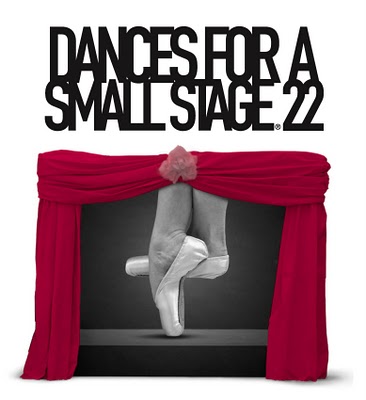Dances for a Small Stage 22: to what end all this skill?

Okay, I am going to come clean here as someone who likes small stages. Someone who thinks it might be a good idea to put tape on the stage to mark out an even smaller space to dance in. Who thinks maybe a kid’s inflatable swimming pool — with water in it — would make a good small stage. This was my first time at “Dances for a Small Stage,” and I kind of felt like the stage was not small enough.
Don’t get me wrong: the dancers are beautiful, the atmosphere is lively, and the audience is having a hell of a time. The informal setting (with the audience sitting at café tables) allows for interaction between dancers and audience, and indeed, the dancers enter by undulating and spiraling through the audience. Some of the audience members chair-dance back. At close range, the dancers’ strength and flexibility and vitality is inspiring.
The first piece, Clique, choreographed by Gioconda Barbuto and danced by the entire company, showcases the spirit and energy of these young dancers as the dancers stand in an open circle, encouraging and applauding, while one or two at a time go center stage and show off for each other and the audience with high kicks, amazing jumps, twirling handstands, and gorgeous partnering (women lifting men, too). The choreography highlights their powerful, individual bodies. This is a strong and emblematic opening to the show—self-aware about the trick-doing elements of ballet, but in a more modern idiom. The men’s bodies seem especially various and therefore interesting, ranging from compact and heavily muscled to slender and almost ethereal.
“Pocket full of hoyle,” choreographed by Farley Johansson and danced by Alexis Fletcher and the inimitable Gilbert Small, continues the trick-doing theme, as the dancers pull a seemingly unending number of playing cards from each others’ pockets and flip them onto the stage. What begins feeling a little silly becomes impressive as they keep going and going and going with it. Fletcher takes off the hood of her hoodie-dress costume and comes out of her shell as the dance progresses, finally pulling out the last card with an ironic grin.
“Love in an Elevator,” which is distributed through the program in three parts, “Oops Sorry LOL Shˆt,” and “Mademoiselle Meringue à l’état sauvage,” all display a kind of goofy humor that the audience and dancers seemed to really enjoy—the opposite of ballet seriousness or prissiness. Marianne Grobbelaar as the elevator girl and Connor Gnam as a strange blind date are particularly Mr. Bean-ish. Cherice Barton’s “Temptation” riffs off the broken smoky riffs of Tom Waits. "Zak," choreographed by Laurie Stallings, has a more serious focus, and a repeated melting gesture that is arresting.
Of all of the work, Margie Gillis’s “Moon on White Crow,” danced by Maggie Forgeron, most got my attention. It is lovely (a white gown, the suggestion of Gillis’s long hair, Forgeron’s light limbs and delicate grace), and built around an emotional heart that conveys itself through the movements without mime or narrative. I don’t know the experience, image, or story that inspired this piece, but I got a strong impression of grace, fragility, balancing.
It’s great to be exuberant and powerful and young and goofy, and these dancers are very well trained and they are using the full range of their physical bodies. Wow! You have to be amazed and delighted by their discipline and beauty. But to what end all this skill? I am not sure what my problem is, because I applaud Ballet B.C.’s move onto the small stage, and I want them to expand their audience and have lots of success, and I sure can’t dance like these amazing dancers, and I don’t think that all dance has to be the same or that there’s no place for exuberant trick-doing, or that dance has to be gut wrenching to be good. But the small stage has been home to some powerful dance art. There are disciplines of modern and contemporary dance that are not ballet and yet are rigorous and deep, that are about connecting with breath and body and artistic structure, that have a history in which people live and move. I guess I wanted to see more of that.



